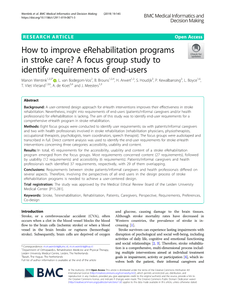Background: Implementation of an eRehabilitation intervention named Fit After Stroke @Home (Fast@home) – including cognitive/physical exercise applications, activity-tracking, psycho-education – after stroke resulted in health-related improvements. This study investigated what worked and why in the implementation. Methods: Implementation activities (information provision, integration of Fast@home, instruction and motivation) were performed for 14 months and evaluated, using the Medical Research Council framework for process evaluations which consists of three evaluation domains (implementation, mechanisms of impact and contextual factors). Implementation activities were evaluated by field notes/surveys/user data, it’s mechanisms of impact by surveys and contextual factors by field notes/interviews among 11 professionals. Surveys were conducted among 51 professionals and 73 patients. User data (n=165 patients) were extracted from the eRehabilitation applications. Results: Implementation activities were executed as planned. Of the professionals trained to deliver the intervention (33 of 51), 25 (75.8%) delivered it. Of the 165 patients, 82 (49.7%) were registered for Fast@home, with 54 patient (65.8%) using it. Mechanisms of impact showed that professionals and patients were equally satisfied with implementation activities (median score 7.0 [IQR 6.0–7.75] versus 7.0 [6.0–7.5]), but patients were more satisfied with the intervention (8.0 [IQR 7.0–8.0] versus 5.5 [4.0–7.0]). Guidance by professionals was seen as most impactful for implementation by patients and support of clinical champions and time given for training by professionals. Professionals rated the integration of Fast@home as insufficient. Contextual factors (financial cutbacks and technical setbacks) hampered the implementation. Conclusion: Main improvements of the implementation of eRehabilitation are related to professionals’ perceptions of the intervention, integration of eRehabilitation and contextual factors.
DOCUMENT

Objective: Despite the increasing availability of eRehabilitation, its use remains limited. The aim of this study was to assess factors associated with willingness to use eRehabilitation. Design: Cross-sectional survey. Subjects: Stroke patients, informal caregivers, health-care professionals. Methods: The survey included personal characteristics, willingness to use eRehabilitation (yes/no) and barri-ers/facilitators influencing this willingness (4-point scale). Barriers/facilitators were merged into factors. The association between these factors and willingness to use eRehabilitation was assessed using logistic regression analyses. Results: Overall, 125 patients, 43 informal caregivers and 105 healthcare professionals participated in the study. Willingness to use eRehabilitation was positively influenced by perceived patient benefits (e.g. reduced travel time, increased motivation, better outcomes), among patients (odds ratio (OR) 2.68; 95% confidence interval (95% CI) 1.34–5.33), informal caregivers (OR 8.98; 95% CI 1.70–47.33) and healthcare professionals (OR 6.25; 95% CI 1.17–10.48). Insufficient knowledge decreased willingness to use eRehabilitation among pa-tients (OR 0.36, 95% CI 0.17–0.74). Limitations of the study include low response rates and possible response bias. Conclusion: Differences were found between patients/informal caregivers and healthcare professionals. Ho-wever, for both groups, perceived benefits of the use of eRehabilitation facilitated willingness to use eRehabili-tation. Further research is needed to determine the benefits of such programs, and inform all users about the potential benefits, and how to use eRehabilitation. Lay Abstract The use of digital eRehabilitation after stroke (e.g. in serious games, e-consultation and education) is increasing. However, the use of eRehabilitation in daily practice is limited. As a first step in increasing the use of eRehabilitation in stroke care, this study examined which factors influence the willingness of stroke patients, informal caregivers and healthcare professionals to use eRehabilitation. Beliefs about the benefits of eRehabilitation were found to have the largest positive impact on willingness to use eRehabilitation. These benefits included reduced travel time, increased adherence to therapy or motivation, and better health outcomes. The willingness to use eRehabilitation is limited by a lack of knowledge about how to use eRehabilitation.
MULTIFILE

Background: A user-centered design approach for eHealth interventions improves their effectiveness in stroke rehabilitation. Nevertheless, insight into requirements of end-users (patients/informal caregivers and/or health professionals) for eRehabilitation is lacking. The aim of this study was to identify end-user requirements for a comprehensive eHealth program in stroke rehabilitation. Methods: Eight focus groups were conducted to identify user requirements; six with patients/informal caregivers and two with health professionals involved in stroke rehabilitation (rehabilitation physicians, physiotherapists, occupational therapists, psychologists, team coordinators, speech therapist). The focus groups were audiotaped and transcribed in full. Direct content analysis was used to identify the end-user requirements for stroke eHealth interventions concerning three categories: accessibility, usability and content. Results: In total, 45 requirements for the accessibility, usability and content of a stroke eRehabilitation program emerged from the focus groups. Most requirements concerned content (27 requirements), followed by usability (12 requirements) and accessibility (6 requirements). Patients/informal caregivers and health professionals each identified 37 requirements, respectively, with 29 of them overlapping. Conclusions: Requirements between stroke patients/informal caregivers and health professionals differed on several aspects. Therefore, involving the perspectives of all end users in the design process of stroke eRehabilitation programs is needed to achieve a user-centered design.
MULTIFILE
